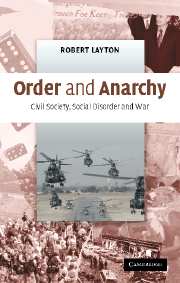3 - The breakdown of social order
Published online by Cambridge University Press: 23 November 2009
Summary
This chapter addresses two questions: what turns civil society against the state? What causes co-operation and reciprocity within civil society to give way to competition and conflict? The analysis is based on a combination of two theoretical approaches, the social theory of Pierre Bourdieu and Anthony Giddens, and the applications of game theory developed by behavioural ecologists. Bourdieu and Giddens, whose ideas are mentioned in chapter 2, were critical of two preceding schools of thought in social science. They argued for a synthesis that would acknowledge the strengths of both, but overcome the weaknesses of each school. On one hand there was a sociological tradition that considered individuals to be embedded in a social system, not free agents (classically represented in anthropology by Durkheim 1938 and Radcliffe-Brown 1952). According to this school, we are born into a society that allocates us to pre-determined social roles, so that everyone plays their part in sustaining the social order. Bourdieu and Giddens objected to this school's tendency to imply that social systems were inherently stable, and that individuals' interests were subordinated to the needs of society (Bourdieu 1977: 5, Giddens 1984: 25). Such ‘structural’ analysis also tended to render variation in individual performances as deviations from an unwritten score (the roles that individuals play on behalf of society), but Bourdieu argued that these roles are in fact sociological constructs built by the analyst. Both Bourdieu and Giddens argued that social order emerges spontaneously through interaction.
- Type
- Chapter
- Information
- Order and AnarchyCivil Society, Social Disorder and War, pp. 92 - 137Publisher: Cambridge University PressPrint publication year: 2006



